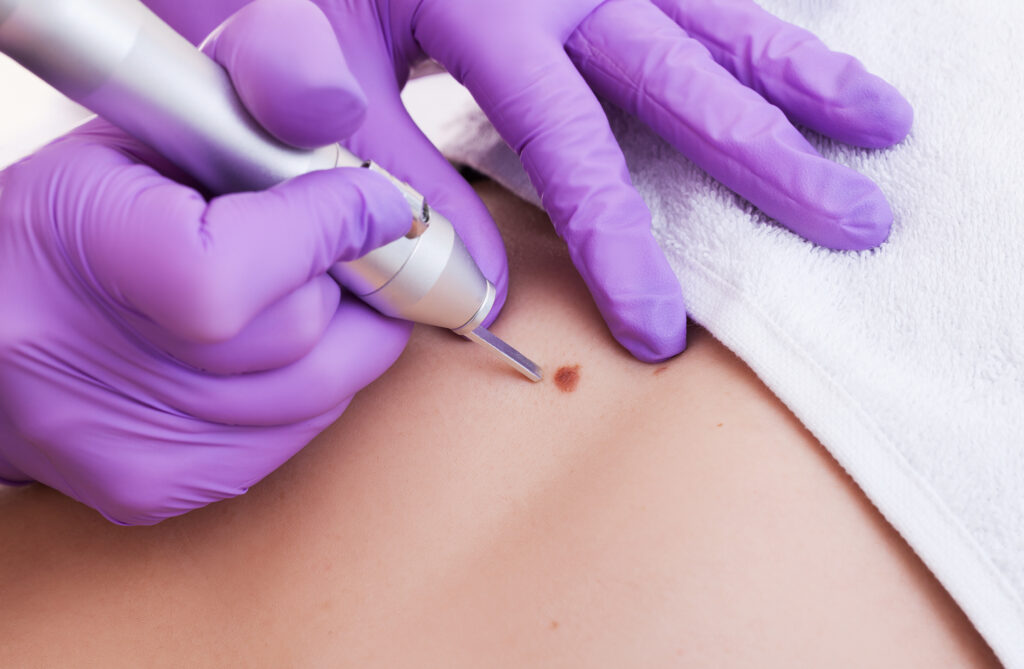
Seborrhoeic Keratosis
Seborrhoeic keratosis (SK), also known as a Seborrhoeic wart or Basal Cell Papilloma is a type of benign skin growth characterised by raised lesions that typically appear on the torso or face in middle age. They can also occur in the genitalia, especially over the pubic area, and are often confused with genital warts.
Keratin is a normal protein produced by specialised epithelial cells present in the skin called keratinocytes. Keratosis is a condition in which there is either overgrowth of keratinocytes or excess production of keratin by these cells, forming raised lesions on the skin.

Symptoms of Seborrhoeic Keratosis
Seborrhoeic keratosis appears as a growth on the skin and has a typical “stuck on” appearance, with a dull, waxy, or “warty” surface, however, it may also appear flat. The lesion is usually darker than the surrounding skin and may appear black, brown, yellow, grey, or flesh-colored.
They typically appear as more than one lesion and may number in the tens or hundreds. Typically a single keratosis is 1–3 cm in size, however may be much larger. The surface of a keratosis may be smooth or may be bumpy, similar to a wart or verruca. SK lesions tend to grow with age and become more numerous over time.
A seborrhoeic keratosis typically does not have any symptoms, however, in some cases can become irritated or itchy or can catch on clothing. Some people with SK are self-conscious of the lesions and it can have a significant impact on self-esteem.
The lesion(s) can appear anywhere on the body, including the genitalia. However, they most commonly affect the face, neck, and trunk.
Causes of Seborrhoeic Keratosis
Seborrhoeic keratosis occurs as a result of the proliferation (growth) of keratinocytes, a type of cell found in the skin. There is thought to be a genetic predisposition to developing Seborrhoeic keratosis, with a correlation between mutations in a receptor called fibroblast growth factor receptor-3 and the development of Seborrhoeic keratosis. The presence of the PIK3CA gene may also be involved in driving the growth of Seborrhoeic keratosis.
It’s not clear what triggers an individual to develop SK, however, there may be links between viral infection and sun exposure.

Prognosis of Seborrhoeic Keratosis
Seborrhoeic keratosis tends to persist for life, with some lesions becoming larger or more raised over time. You may also develop more lesions over time. The condition rarely resolves by itself. There is no increased risk of skin cancer for someone with SK.
Get Tested with Confidence
Consultation
Testing
Treatment
Frequently Asked Questions
What are the symptoms of Seborrhoeic keratosis?
Seborrhoeic keratosis appears as a growth on the skin and has a typical “stuck on” appearance, with a dull, waxy, or “warty” surface, however, it may also appear flat. The lesion is usually darker than the surrounding skin and may appear black, brown, yellow, grey, or flesh-colored.
They typically appear as more than one lesion and may number in the tens or hundreds. Typically a single keratosis is 1–3 cm in size, however may be much larger. The surface of a keratosis may be smooth or may be bumpy, similar to a wart or verruca. SK lesions tend to grow with age and become more numerous over time.
A seborrhoeic keratosis typically does not have any symptoms, however, in some cases can become irritated or itchy or can catch on clothing. Some people with SK are self-conscious of the lesions and it can have a significant impact on self-esteem.
The lesion(s) can appear anywhere on the body, including the genitalia. However, they most commonly affect the face, neck, and trunk.
Who can get Seborrhoeic keratosis?
Seborrhoeic keratosis typically tends to affect middle-aged and elderly people, however, it can appear in people of any age. They may start earlier in life as small raised lesions, which can grow in size or number over time. It occurs equally in men and women and is more common in people with fairer skin tones. Seborrhoeic keratosis has a genetic component and is more likely to occur in people with affected relatives.
Are there different types of Seborrhoeic keratosis?
Seborrhoeic keratosis is known to occur as several distinct subtypes including:
- Acanthotic
- Hyperkeratotic
- Clonal
- Adenoid
- Irritated
- Melanoacanthoma
Are there any complications of Seborrhoeic keratosis?
Seborrhoeic keratosis lesions can sometimes become irritated, particularly if they catch on clothing or are in an area exposed to friction. SK is not pre-cancerous and there is no increased risk of skin cancer.
I think I have Seborrhoeic keratosis. What should I do?
If you think you have Seborrhoeic keratosis, it’s important to see a healthcare professional for an accurate diagnosis. SK can mimic other conditions such as melanoma which do require treatment, so it’s important to get a proper diagnosis.
Is Seborrhoeic keratosis an infection?
Seborrhoeic keratosis is not an infection and rather is a benign overgrowth of skin cells.
Is Seborrhoeic keratosis a type of cancer?
Seborrhoeic keratosis is not a cancer and does not develop into cancer. It can sometimes look similar to Melanoma, a type of skin cancer, hence it is important to have any new skin lesions changed by a qualified healthcare professional.
How is Seborrhoeic keratosis diagnosed?
Seborrhoeic keratosis is typically diagnosed through a thorough history and clinical examination by a qualified healthcare professional. Classic “stuck on”, warty-appearing lesions in someone over the age of 40 are typical findings of SK. Provided there are no atypical or worrying features, the diagnosis can often be made without the need for any additional tests.
If there is any diagnostic uncertainty, a closer examination of the skin may be undertaken through the use of a dermatoscope (a kind of magnifying glass).
If there is any concern about malignancy, a skin biopsy should be performed. A skin biopsy is usually performed in a clinic environment with the use of a local anaesthetic. A small sample of the lesion is taken, which is examined under microscopy in a laboratory.
Seborrhoeic keratosis lesions in the genital area are often misdiagnosed as genital warts, which can have a major impact on psychological health and self-esteem for some patients. SK lesions can very much look like warts and have a tendency to recur similar to warts.
We often see patients who have been wrongly diagnosed to have Genital warts whilst in fact they have got SK. Where a distinction between SK and genital warts is very important for the patient, histopathological examination and HPV testing of the biopsied lesions should be considered. In our experience, conclusively confirming the diagnosis of SK, and ruling out Genital warts can have a life-transforming effect on many patients.
What factors can help a correct diagnosis?
A correct diagnosis is more likely to be reached when your skin is thoroughly examined by a professional with experience in genital dermatology (the study of the skin and skin conditions). This may be a general practitioner, nurse or specialist dermatologist.
An accurate history of when the lesion(s) appeared, and if any other signs or symptoms are present can also aid in diagnosis. If there is any diagnostic uncertainty, a sample (biopsy) of the lesion may be taken to look more closely at the cellular makeup.
What other conditions can Seborrhoeic keratosis be mistaken for?
Seborrhoeic keratosis can appear similar to other skin conditions such as:
- Melanoma
- Melanocytic naevus
- Squamous cell carcinoma
- Basal cell carcinoma
- Actinic keratosis
It’s important to have any new skin lesion examined by a qualified healthcare provider for an accurate diagnosis.
What is the difference between Melanoma and Seborrhoeic keratosis?
Seborrhoeic keratosis is a benign (non-cancerous) skin growth whereas Melanoma is a form of skin cancer. They can look very similar, so it’s important to get any new skin growths assessed by a qualified healthcare professional. Melanoma tends to appear as solitary lesions, whereas Seborrhoeic keratosis usually appear as multiple lesions.
Seborrhoeic keratosis typically has a characteristic “stuck on” appearance, with regular edges and uniform colour, whereas Melanoma often has a more irregular border, and can contain many different hues of colour. Melanoma can grow rapidly and may change shape or colour over time. Bleeding is more common with Melanoma than SK.
What is the difference between Actinic keratosis and Seborrhoeic keratosis?
Actinic keratosis is an inflammatory skin condition characterised by dry, scaly skin that occurs on sun-exposed areas. In contrast, Seborrhoeic keratosis is the presence of distinct, raised, brown lesions.
What is the difference between Seborrhoeic Dermatitis and Seborrhoeic keratosis?
Seborrhoeic dermatitis is a long term skin disorder characterised by patches of itchy, scaly, greasy skin on the face, scalp and chest, areas of the body with large numbers of sebaceous glands. It’s thought to be related to an overgrowth of a certain type of fungus and can be effectively treated with topical agents. Seborrhoeic keratosis is a distinct growth on the skin, and doesn’t occur in patches and is not usually itchy or greasy. SK can appear on any part of the body and does not require any treatment.
How can I prevent Seborrhoeic keratosis?
There are no known ways to prevent Seborrhoeic keratosis from developing.
What changes should I watch out for?
Like any skin lesion, it’s important to watch out for any changes, which may indicate a rapidly evolving skin lesion.
- Rapid growth
- Bleeding or scabbing
- Becoming red or irritated
- Pain
- Changes in colour
- Changes in shape
If any of these changes occur, you should see a healthcare professional experienced in skin examination.
How can I manage the stigma around Seborrhoeic keratosis?
For people living with SK, there may be a stigma surrounding abnormal-looking skin, particularly if lesions are on the face or genitals. It’s important to remember that SK is a benign, harmless condition that is no reflection on personal hygiene. For those with significant psychological sequelae triggered by the presence of SK, removal may be considered.
Author:
Page reviewed by Dr. Manoj Malu (Clinical Director)
Last reviewed date: 6 June 2021
Next review due: 6 June 2024
Whilst this content is written and reviewed by sexual health specialists, it is for general guidance only. It is not intended to replace the advice of your clinician.
References & Further Reading
- StatPearls (2021): Seborrheic keratosis
- Healthline (2017): Seborrheic keratosis
- The Royal Australian College of General Practitioners (2019): Benign pigmented skin lesion
- Patient.info (2021): Seborrhoeic Warts
- British Association of Dermatologists (2018): Seborrhoeic Dermatitis
- British Association of Dermatologists (2017): Seborrhoeic keratosis
- Primary Care Dermatology Society (2021): Seborrhoeic keratosis
- Dermnet NZ (2016): Seborrhoeic keratosis
- Dermnet NZ (2011): Seborrhoeic keratosis images
- Medscape (2020): Seborrheic keratosis
- Mayo Clinic (2019): Seborrheic keratosis
- NHS University Hospitals Birmingham (2020): Seborrhoeic keratosis
- British Association of Dermatologists (2008): Cryotherapy
- Journal of Drugs in Dermatology (2015): Current Understanding of Seborrheic keratosis: Prevalence, Etiology, Clinical Presentation, Diagnosis, and Management
- BMJ Best Practice (2018): Seborrhoeic keratosis


